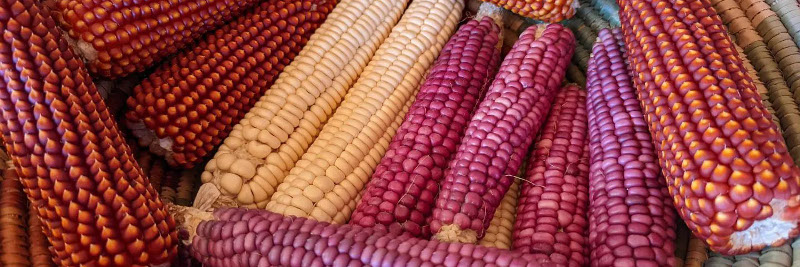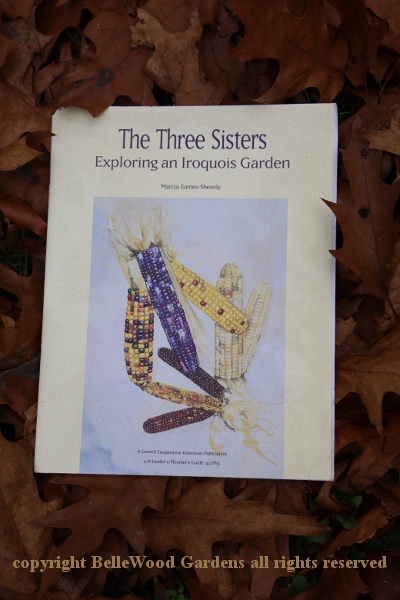
image courtesy of the New York Botanical Garden
.
If you have any comments, observations, or questions about what you read here, remember you can always Contact Me
All content included on this site such as text, graphics and images is protected by U.S and international copyright law.
The compilation of all content on this site is the exclusive property of the site copyright holder.
Seeds of Resilience with Rowen White
A New York Botanical Garden on-line zoom meeting
Thursday, 9 November 2023
As described in the New York Botanical Garden's Continuing Education: "Explore stories from the Indigenous Land and Seed Sovereignty movement, which embodies the vision of sustainable relational agriculture and shares the depth of the cultural dimension of plant biodiversity in North America. Mohawk Seedkeeper Rowen White will share insight into the collective vision of intercultural healing that emerges when we center Indigenous leadership, ecological knowledge, cultural memory, and sovereignty of living in relationship with the inheritance of land, seeds, and other non-human kin."

image courtesy of the New York Botanical Garden
"Rowen White is a seedkeeper, farmer, activist, and author from the Mohawk community of Akwesasne. She is the Creative Director of Sierra Seeds, an innovative Indigenous seed bank and land-based educational organization located in North San Juan, CA, and founder of the Indigenous Seedkeepers Network, which is committed to restoring the Indigenous Seed Commons. In recognition of her work to create a safer, equitable, and sustainable food world, White received the distinguished James Beard Leadership Award in 2023."
I was intrigued by the description of this Zoom talk. Back in October 2021 I attended a presentation at the Bouman Stickney farmstead and museum in Readington Township, about Lenape Lifeways. The presenter's focus was primarily on food and food crops. Her discussion included mention of puhwem corn, a Lenape flour corn for corn bread and dumplings.

Available from Truelove Seeds, their catalog description mentions how Puhwem Corn was stewarded by Nora Thomson Dean (Touching Leaves Woman) and her family in the Lenape/Delaware community in "Indian Territory," Oklahoma. Born in 1907, she spent the later half of her life preserving and documenting the knowledge and traditions of Lenape people. An excerpt from the 1971 article "Delaware Ethnobotany" by George A Hill Jr. in which he interviewed Nora Dean and other Lenape elders. Nora was working on her own cookbook, which was published after her death, called "Lenape Indian Cooking," and it includes many traditional and modern corn preparations and recipes. Gladys Tantaquidgeon, Mohegan anthropologist and medicine woman, wrote "Folk Medicine of the Delaware and Related Algonquin Indians." In her section on corn, she describes a world of rituals connected to the Spirit of Mother Corn as well as ceremonial diets and the medicines of corn, of which only vestiges remain.

Cornell Cooperative Extension has an excellent, informative publication, The Three Sisters, Exploring an Iroquois Garden. Its focus is on the - call it polyculture - utilizing corn as the vertical plant which supports the vining beans with squash as a spreading, weed suppressing groundcover, rather than our perhaps more familiar "keep everything growing, row by row, in its own separate place." Even more, there is discussion of how to collect oral history stories, information on foods prepared from corn (bread, corn pudding, samp (coarsely ground corn mixed with berries or meat), wedding bread (prepared the same as for boiled corn bread, wrapped in a corn husk and tied in the middle to look like a dumbbell.) Corn husks used to weave baskets, door mats, and more. I especially enjoyed the description of re-discovering Delaware grandfather corn, where each individual kernal has a husk, even though the cob is still covered as we know familiarly it.
So when I received a notice about Rowen White's zoom presentation, Seeds of Resilience it caught my attention. Here would be yet a different exploration of this subject. Indeed. Rather than plants, food, recipes, Seeds of Resilience was an exploration of the role of culture as it relates to biodiversity. Belonging, culture, and connection as a way for Rowen White to find her way home through food and seeds. It is not enough, she explained to us, to save heritage seeds in freezers or museums. They must be kept in our lives.
It is something, she shared with us, that can travel in both directions: tomatoes, so variable in color, size, shape, and savor, travelled from the New World to Italy. And a couple of hundred years later, when Italians immigrated to the United States, small packets of tomato seeds from their ancestral villages came with them.
Consider seed availability and access, open pollinated with varietal suitability, what's termed "landrace seed" that is site and culturally specific with inherent diversity.

Let me interject here, that The Shop at the New York Botanical Gardens
conveniently offers heirloom seeds from several commercial vendors.
Seeds of Resilience. The creation story of the Mohawk, Rowen White shared with us, tells how Sky Woman fell from outer space. An enormous turtle emerged from the waters covering the earth to save her on its back. Pregnant, she has a daughter who becomes pregnant by the West Wind, with twins. One twin son is born normally. The other son, who has a crest over his head, is born from her armpit, killing her. Different parts of her body become food plants - corn from her breasts, potatoes from her legs, a vining plant (squash or perhaps beans were mentioned) from the dying daughter's navel. And so were seeds of resilience given to the people who are helping to keep biodiversity and regional differences, from their family and clan to the regions where they live. Not merely their crops, but also other plants growing along paths, in nearby meadows / fields, and at the forest edges.
This presentation had a focus not so much on how-to of plants and gardening, but more on the culture and spiritual life of indigenous people who grow these plants. An intense hour, with much to consider.
Also, throughout November, New York Botanical Garden will be celebrating Native American Heritage Month. On-site programming and digital offerings will highlight Native American plant-based traditions both in and around the 50-acre, old-growth native forest—the largest uncut expanse of New York City’s original wooded landscape—as well as digital offerings highlighting the plant-based traditions of Native Americans from the Northeast and throughout the Americas.
Located on land that is part of Lenapehoking, the traditional homeland of the Lenni Lenape people, which extends from northern Delaware north to the Hudson Valley, and from eastern Pennsylvania to western Connecticut. The Lenape lived in this territory for thousands of years before the arrival of Europeans, and still maintain their communities and cultural practices in this area today.

image courtesy of the New York Botanical Garden
Back to Top
Back to November
Back to the main Diary Page